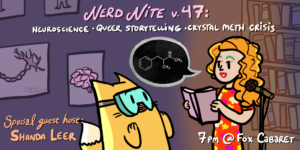Fall is upon us. It’s time to bust out your hipster beanie, wait extra-long in a coffee line while everyone orders a pumpkin spiced latte, and crunch through the fallen leaves while wondering: what’s up with these leaves changing colour? It turns out that colour change is driven by less daylight. The green pigment chlorophyll, which starts the process of photosynthesis, breaks down. In the summer chlorophyll is replenished, but in the fall the veins bringing water and nutrients to the leaves close off and so when the chlorophyll breaks down and isn’t regenerated, the green pigments fade. This allows the yellow and orange pigments that were already in the leaf to become the stars of the show. But wait… what about the reds? Unlike the orange and yellow pigments, the red pigments form during the fall. With the closing of the veins, the sugars that are normally transferred from leaf to tree branches get trapped in the leaf. These sugars react with other chemicals to form red pigments – more sugars trapped in the leaves = brighter reds! So while leaves change colour and then peace-out with less daylight, at Nerd Nite we’re embracing those cooling fall nights with another line up of amazing speakers who will teach us about neuroscience, overcoming stigma around crystal meth use, and queer storytelling.
When: Wednesday October 16th; Doors @ 7, show starts @ 7:30
Co-Hosted by: Michael Unger
Special guest host: Shanda Leer
Poster by: Armin Mortazavi
DJ: Grant Francis Minor – DJ Burger

1. The Struggles of Being a Socially Awkward Adolescent Rat
Travis Hodges
Social experiences are very important during adolescence, such that disrupting those experiences results in lasting changes in social behaviour and in specific brain regions. Compared to other age groups, the adolescent brain is also the most susceptible to social stressors. In adolescent rats, I altered their social experiences by changing their cage partners every day for a little over two weeks (similar to moving a child to a new school several times or through foster homes several times during adolescence) and this resulted in the rats becoming socially awkward with their adolescent peers and then with their adult peers when they became adults. I will talk about why rats are cute, the similarities between adolescent rats and adolescent humans, how socially awkward behaviours caused by stress in adolescence manifest in adulthood, and what systems in the brain are involved in social awkwardness. Our past social experiences have already molded how we act as adults, but hopefully these findings will stress the importance of providing coping strategies to current and future adolescents in stressful social situations.
Bio: Travis received a PhD in Psychology with training in Behavioural Neuroscience from Brock University in St. Catharines, Ontario. Travis now works as a postdoctoral fellow in the lab of Dr. Liisa Galea at the Djavad Mowafaghian Centre for Brain Health at UBC. Travis’s research projects have always focused on the sex-specific impact of stress on the brain from early-life to adulthood. A main focus of his PhD was determining what changes in the brain result in social awkwardness after social stress in adolescence and in a rat model. Travis’s research at UBC focuses on the brain regions involved in negative cognitive biases or pessimism, and how stress and altering the amount of new born neurons in the brain affect negative cognitive biases in males vs. females and in adolescents vs. adults using rodent models. Travis is a member of the Women’s Health Research Cluster (WHRC) and a committee member of the Cluster’s Trainee Presentation series. The WHRC Trainee Presentation Series aims to get young researchers to present research that focuses on women’s health and form connections with other researchers and the rest of the community. When he is not in the lab, Travis is a huge fan of watching horrible movies, singing at karaoke, and dancing away life’s stressors.
2. From Forest Nymph to Limp Wrist: The Art of Queer Storytelling
David Cutting
Enjoy this weird and wonderful presentation that explores the genesis of queer identity through embracing pop culture and, hopefully, inspires you to seek out and absorb your queer friends’ own stories.
Bio: David Cutting is a local drag performer, producer and creative. Their Drag persona Dust can be caught hosting Commercial Drag, a Bi weekly drag show and Yuk it up Sis a monthlyish Drag Comedy Show at Yuk Yuks Comedy Club.
You can follow David at @unicornriverchild
3. Let’s Talk About Vancouver’s Crystal Meth Crisis
Lisa Allyn
When I say “there’s a drug crisis in Vancouver,” does crystal meth come to mind? I’ve come to realize that few people outside the bubble of healthcare, social services, and law enforcement appreciate the extent and urgency of the gigantic decade-long crystal meth crisis in our city. It’s fascinating and shocking. Why aren’t we urgently working on solutions to a huge problem that for a decade has been in plain sight, has ended and damaged countless lives, and drains our limited public resources? Let’s start breaking bad habits – it’s time to talk openly about Meth. Is it really blue? Why do users use it? What are the impacts & scale of the crisis? How does meth use relate to trauma, shame, stigma and wealth inequality? We’ll go over concrete steps we can all take toward healing the devastations of crystal meth use in our communities, including practical tips for being better neighbours and allies.
Bio: Lisa Allyn is a brain, behaviour, and trauma nerd who works in rehabilitation and recovery with substance users in Downtown Vancouver. She is trained as an occupational therapist. OTs specialize in providing interventions (tools, strategies, equipment, supports) for all kinds of functional deficits (eg. challenges putting on clothing, writing a budget, driving a car, playing hockey).
